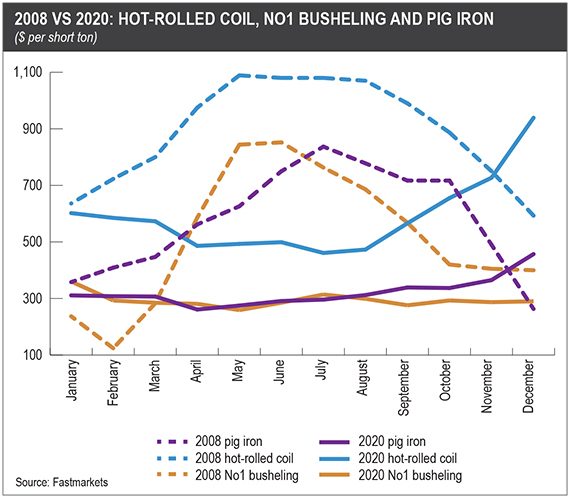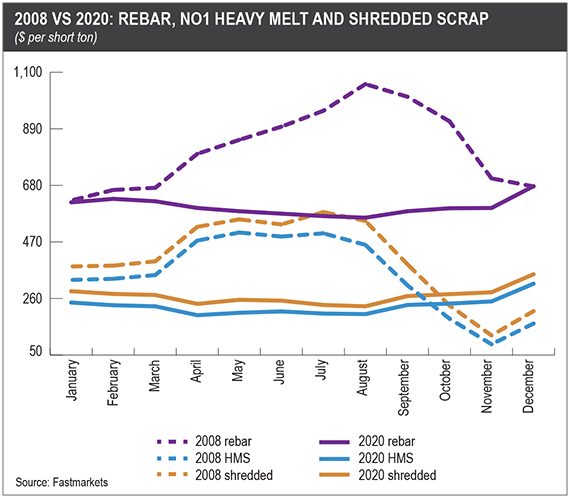That year, finished steel prices shot to their highest levels yet, while raw materials rose, and sank, at record pace. In the following review and outlook, Fastmarkets’ steel reporters Thorsten Schier and Mark Shenk – along with principal steel consultant Amy Bennett – look at some of the factors that drove volatility then, what is driving it now, and what the market can expect for 2021 following the record highs of last year.
What most market participants we spoke to agree on is that the factors this time around differ significantly from when the commodity super-cycle was at its peak in 2008.
“Today is very different; there are US issues and world issues. So far in January, crude steel output is 10% below last year, but producers will not restart integrated capacity, even with current prices, because they lack confidence,” John Tumazos, president and metals analyst with John Tumazos Very Independent Research, told Fastmarkets.
The same goes for other commodities, like wood, Tumazos said, where tight supply is driving prices higher despite returning demand and backlogs. And one factor that may be behind producers’ lack of confidence is the changing US presidential administration, which means uncertainty around things like environmental regulations, taxes and the Section 232 duties on foreign steel.
Also, shortages of certain raw materials – due to absenteeism in the labor force and underproduction due to Covid-19 restrictions – could also be contributing factors, Tumazos said.
“This is really unique, because the companies have orders and they don’t want to produce more,” he said.
During 2008, there was a broad-based commodity rally that ended end in September when the bankruptcy of Lehman Brothers helped spark the Great Recession, sending both steel and raw material prices tumbling. Last year, steel and raw material prices dropped after the Covid-19 pandemic shuttered much of the global economy during the second quarter. Steel rebounded during the second half of 2020, while raw materials lagged.
“In 2008, we were at the peak of the global commodity boom with oil prices at $100 [per barrel],” Philip Gibbs, equity research analyst at KeyBanc Capital Markets, said. “It was also the peak of the global demand cycle, so raw material input prices hit new highs.”
Fastmarkets looked at two sets of interlinked finished steel products and their raw materials to be able to compare these two volatile years: the spreads between hot-rolled coil, busheling scrap and pig iron, and those between rebar, heavy melting scrap and shredded scrap.
HRC, busheling, pig iron
Fastmarkets’ daily steel hot-rolled coil index, fob mill US hit $56.25 per cwt ($1,125 per short ton) in May 2008. The consumer buying price for steel scrap No1 busheling, delivered mill Chicago and the assessment for pig iron, import, cfr Gulf of Mexico, US reached respective record highs of $890 per gross ton ($794.64 per short ton) and $930 per tonne ($843.68 per short ton) in July of that year.
HRC reached a new record as 2021 started, and a similar uptrend was seen in raw materials and other commodities.
Fastmarkets’ index surged from a 2020 low at $21.89 per cwt on April 30 to end the year at $51.50 per cwt. Prices further advanced to an all-time high of $58 per cwt on January 14, up by 164.96% from the April low.
“I think the main difference between the two periods is that the price curve preceding 2008 had been driven up initially by raw materials,” said James Moss, a partner at First River Consulting in Pittsburgh, Pennsylvania. “There was a lot of concern then about availability of all kinds of raw materials, including scrap. The current price curve has been driven by the curious dynamics of a pandemic market demand where things can suddenly get active after being largely shut and where inventories are lean.”
US steel mills responded to the pandemic and the resulting economic slowdown by curbing capacity utilization, which tumbled to 51.1% in the week ended May 2, 2020, after fluctuating between 81% and 83% in January and February, according to American Iron and Steel Institute data. Restarts in the automobile industry helped bolster steel demand and led to a rebound in steel capacity utilization rates.
“When prices dropped, mills minimized their supplies of slab, scrap, coal and other raw materials,” Gibbs said. “Until October, mills were running for cash, not profit. Liquidity was their aim, so they depleted their stocks of raw materials.”
Integrated steel producers were responsible for the bulk of the drop in capacity utilization because they idled mills, while mini-mills curbed output without shuttering units, according to Tyler Kenyon, an analyst at Cowan & Co.
During the last five months of 2020 while HRC prices climbed steadily, pig iron rose at a slower rate, and scrap prices did not rally until December.
“Companies and consumers have lower levels of debt than they had in 2008, so they were able to quickly return this time around,” Kenyon said. “In some end markets such as automobiles, you saw a V-shaped recovery.”
Fastmarkets’ price assessment for pig iron, import, cfr Gulf of Mexico, US climbed to $575 per tonne ($521.63 per short ton) on January 15 from $560-575 per tonne ($508.02-521.63 per short ton) a week earlier and roughly double the 2020 low of $285-290 per tonne ($258.55-263.08 per short ton) reached in April. The consumer buying price for No1 busheling, delivered mill Chicago rose by $80 in December and $100 in January, reaching $480 per gross ton ($428.57 per short ton) on January 11; that price is up 84.62% from an August 2020 low of $260 per gross ton ($232.14 per short ton).
But still, “we don’t have the same supply problems in raw materials that we do in finished products,” John Foster, president of Kurt Orban Partners, said. This is the main difference between the rallies in 2008 and last year, he said.

Rebar, heavy melting scrap and shred
Strong but gradually waning demand and a significant raw material cost push sent Fastmarkets price assessment for steel reinforcing bar (rebar), fob mill US to its highest ever in 2008. The price started the year at $29.75 per cwt ($595 per short ton) and reached $52.80 per cwt ($1,056 per short ton) in the late summer, only to fall back to $33.80 per cwt ($676 per short ton) in November and December as raw material prices nosedived.
The No1 heavy melt consumer buying price, delivered mill Chicago climbed as high as $515 per gross ton ($459.82 per short ton) in May and July 2008, before plummeting to $90 per gross ton ($80.36 per short ton) in November. The consumer buying price for shredded auto scrap, delivered mill Chicago climbed to $605 per gross ton ($540.18 per short ton) in July 2008, only to dip as low as $125 per gross ton ($111.61 per short ton) that November.
Overall, the rebar price rose by 13.61% during the year, while the No1 heavy melt and shredded prices fell by 34.17% and 26.34% respectively.
Fastmarkets described demand as “tepid” in mid-year 2008, but sources thought prices would be supported by the gains in raw materials. Those were not thought to waver much, but ended up falling off a cliff by year-end.
In the words of one scrap executive at the time: “I don’t know of anyone that is experiencing what you experience before a big market crash, where you have a lot of scrap deliveries and people are getting flooded with scrap. That’s not happening.” He pointed to solid steel mill utilization rates as his reasoning.
In comparison, 2020 shows a steadier picture, at least for rebar. Prices did not rise as drastically as they did in 2008, with rebar reaching a year-to-date high of $37 per cwt ($740 per short ton) on December 30. Meanwhile, No1 HMS and shredded scrap rose modestly through the year, peaking at $335 per gross ton ($299.11 per short ton) and $370 per gross ton ($330.36 per short ton) respectively, also in December.
Rebar ended 2020 up by 23.33% from January levels, while No1 heavy melting scrap rose by 48.89% and shredded by 38.58%, according to Fastmarkets’ calculations.
The steady gains meant margins for producers held fairly stable, Fastmarkets AMM data shows. US long products capacity, exclusively electric-arc furnace (EAF)-based, was not curtailed to the degree that flat-rolled was, leading to more stability even when demand rebounded.
And rebar’s typical end market, construction, with its longer lead times, did not decline as much as automotive and other white goods that consume flat-rolled products.
“Construction wasn’t hit as badly as in 2008,” Kenyon said.

Outlook
With flat product prices returning to 2008 highs in late 2020 and early 2021, there is understandably debate regarding a potential repeat of history – with 2008 heights followed by the 2009 crash – and if a similar scenario will emerge in 2021. While we concede that prices have again risen to unsustainable highs and that a downward correction at some point in 2021 is inevitable, we do not foresee a collapse in 2021 on a par with 2009.
A key difference between current market conditions and those witnessed in 2008-09 is that, in the 2008 period, record-high prices encouraged steel and other commodity and raw material producers to maximize production, with ample supply available during the peak pricing period and contributing to the price collapse. In mid-2008, when US hot band prices last exceeded $1,000 per ton, US average mill capacity utilization rates were around 89%.
Despite domestic HRC prices now exceeding $1,000 per ton once again, US steelmakers are operating at an average capacity utilization rate of just 75%, with numerous furnaces still idled from the early 2020 lockdown period. Soaring steel prices in 2020-21 reflect an actual steel supply shortage, not artificially inflated demand and speculation as in 2008. In fact, demand – as measured by US service center steel shipments – has continued to fall, slipping by 1.3% year on year as of November 2020; that marks the lowest rate of decline since February 2020, but supply – which includes total US steel shipments plus net imports – has fallen more acutely, dropping by more than 13% year over year in November, Fastmarkets data shows.
A shortage of key steelmaking raw materials – namely prime busheling scrap in the US and iron ore globally – also has been lending cost-push support to prices in the current cycle. Cost-push pricing support was absent in 2008-09, with ample supplies of competitively priced raw materials available once demand collapsed, amplifying the market downturn.
Rather than the downward pricing spiral that characterized steel prices in late 2008-09, we expect to see a more moderate downward correction in steel prices in mid-2021. The combination of increased domestic production, both from the restart of idled capacity and the ramp-up of new capacity, as well as increased scrap supplies will help to ease the sharp pricing pressure in evidence in late 2020 and early 2021.
Still, with limited import competition – due to elevated steel prices globally, various trade actions previously imposed, and the weak value of the US dollar relative to numerous other global currencies – we forecast prices to remain well above recent historical lows. Still-elevated scrap prices, by historical standards, and stronger end-use consumption in 2021 also are expected to buoy prices this year.




